Texas Railroad History - Tower 191 - Marlin
A Crossing of the Southern Pacific Railroad and the
Missouri Pacific Railroad
 |
Left: Rails in
the pavement on Monroe St. help visualize the crossing of the Southern Pacific (SP)
and Missouri Pacific (MP) railroads on the north side of Marlin, a site interlocked as Tower 191
in 1946. This Google Street View from July, 2023 looks southwest along
the former MP right-of-way. The former SP tracks cross at an acute angle, now owned by Union Pacific (UP).
The rails in the pavement indicate a connecting track between the two lines;
a track chart shows it dating to at least 1915.
From Marlin, the
MP and SP lines both went northwest to Waco, but the SP route was
shorter, with fewer grades and curves. In the mid-1960s when SP planned
to abandon their line through Marlin, MP arranged to buy it and
abandon their Marlin-to-Waco tracks instead. This gave MP a shorter and
easier route to navigate into Waco, hence, UP's track has both
SP and MP heritage.
Having acquired the SP tracks to Waco, MP
needed a connecting point in Marlin. Tower 191 could have served that
purpose if a new connector had been built west of SP's tracks,
approximately where the utility pole on the right now stands. Instead,
where the MP and SP tracks approached Marlin from the south, MP built a
0.7-mile connector between them, abandoning its tracks
farther north as SP abandoned its tracks to the south. |
By an act of the Texas Legislature, Falls County was
carved out of Milam and Limestone counties in 1850, named for waterfalls on the
Brazos River which bisects the county. The law specified a settlement west of
the Brazos as the county seat, but a vote of county residents in January, 1851
relocated the seat to Adams east of the Brazos. Two months later, the
county commissioners voted to rename Adams in honor of John Marlin, a landowner
who had established an early settlement nearby. About fifteen years later, Marlin
became positioned to gain rail service when the citizens of
Waco decided
that the easiest way to obtain a railroad was to build their own.
They proposed to "tap" the main line of the Houston & Texas Central (H&TC) Railway, which had
begun building north out of Houston toward the Red
River prior to the Civil War. The new railroad would be known as the Waco Tap, and it was
chartered by an act of the Texas Legislature on November 5, 1866. Marlin was
virtually assured of rail service; it was 21 miles southeast of Waco in the direction to reach
the H&TC, and its population was growing, reaching 500 in the 1870 Census.
The
Waco Tap had a charter but not much else, not even a corporation to own the
charter; that would come later. It also lacked an obvious
connecting point to the H&TC. During the War, the H&TC's end of track was at Millican, a tiny community between Navasota and
Bryan, well to the northwest of Houston...in
the direction of Waco. A straight line between Waco and Houston
would pass very close to Millican, Navasota and Bryan. The H&TC appeared to be
following the Brazos River toward Waco, remaining generally three to eight miles
northeast of the river. After the Civil War, the H&TC resumed construction with the same northwest
heading paralleling the Brazos, reaching Bryan (seven miles from the river) in
1867 and Hearne (five miles from the river) in
1868. Northwest of Hearne, the H&TC passed through Calvert (six miles from the
river and only 26 miles from Marlin) in 1869. Nine miles beyond Calvert, the H&TC heading turned away from
the Brazos, curving north-northeast. It continued on that heading another five miles
into the town of Bremond, newly founded by the railroad and named for its first
President, Paul Bremond. It was nine miles east of the river and sixteen
miles southeast of Marlin.
In Texas, the unsettled nature of the banking
system and financial markets during the post-War occupation by Federal troops
had motivated the Legislature to specify a procedure for organizing the Waco Tap
company, allowing two years in which to do so. The Waco Tap Railroad Co. was
formally established as the holder of the Waco Tap charter in November, 1868,
and it immediately began negotiating with the H&TC regarding the planned branch
to Waco. The railroads chose Bremond to be their connecting point; the H&TC had
already obtained a right-of-way there, but its tracks were still miles away. The
initial survey work for the Waco Tap began in December, 1868, and a year later, the
Houston Telegraph of December 16, 1869 quoted a
Waco Register
report that "Two miles of
the road are now graded. The junction, Bremond, has been laid off into lots, the
sale of which will commence soon." By the time the first scheduled
H&TC train rolled into Bremond in June, 1870, the railroads had agreed that
the H&TC would perform the construction work for the Waco Tap and would
acquire the line upon completion. In his classic reference book
A History of the
Texas Railroads (St. Clair Publishing, 1941), author S. G. Reed explains
that the H&TC...
"...secured an agreement to build a
branch from Bremond. The H. & T. C., however, did not intend to stop at Waco,
but to extend it through the Panhandle toward Colorado. So the name was changed
by the Legislature on August 6, 1870, to The Waco and Northwestern Railroad
Company."
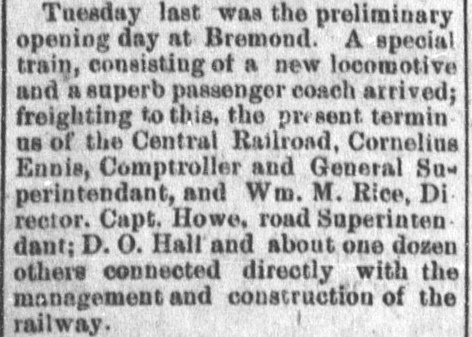 |
H&TC's investors had been
looking at the prospect of building a lengthy branch line into the Texas
Panhandle with Colorado as the long term goal. Waco was an obvious target in
that direction, hence, it made sense to see what might be done under the
Waco Tap's charter. The terms of H&TC's charter prohibited it from
building branch lines until it had completed its main line to the Red
River (which would occur in late 1872), but that did not prevent the
H&TC from connecting to branch
lines built under other charters. Consistent with the idea behind the
Waco & Northwestern (W&NW), Colorado would soon become the foremost
target for Texas railroad expansion. Both the Gulf, Colorado & Santa Fe
Railway and the Fort Worth & Denver City Railway would be chartered in
1873, putting Colorado front and center as an explicit goal.
Left: Although the
first scheduled arrival of an H&TC train into Bremond reportedly took
place on June 15, 1870 to a welcoming crowd of a thousand people, this
news item from the Houston Telegraph
of Thursday, June 2, 1870, quotes the inaugural issue of the
Bremond Central Texan that
"preliminary opening day" at Bremond had taken place "Tuesday last",
which could either mean May 31 (two days earlier) or May 24 (Tuesday of
the prior week.) Various dignitaries of the H&TC were aboard the special
train. |
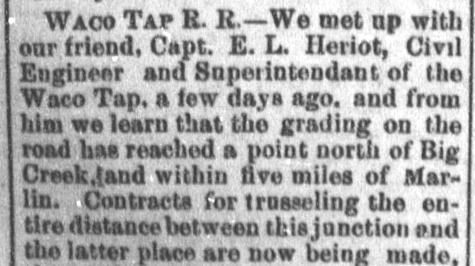
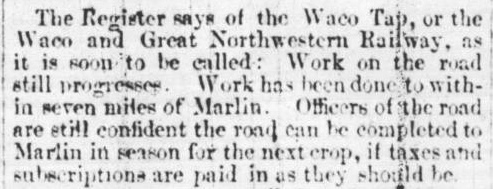 |
Left Top:
While the Houston Evening Telegraph
of June 2, 1870 reported grading north of Big Creek, within five miles
of Marlin...
Left Bottom:
...the Austin Daily State Journal
of June 14, 1870 quoted the Waco Register's
claim that "work" was "within seven miles of Marlin."
The difference may be attributable to the time lag in obtaining the
Waco Register report.
Right: Despite
H&TC taking over the construction effort, the work proceeded slowly. The grading between Bremond and Marlin took another
sixteen months. With the distribution
of ties along the grade also nearly finished, the roadbed was finally
ready for rails. (Austin Weekly
Democrat Statesman, October5, 1871)
Trains finally
operated into Marlin on February 24, 1872 and reached Waco on September
18, 1872. The W&NW was sold to H&TC five months later. Operations of the
Tap (which was still the favored nickname) through Marlin helped spur a
tripling of its population to 1,500 in the 1880 Census. |
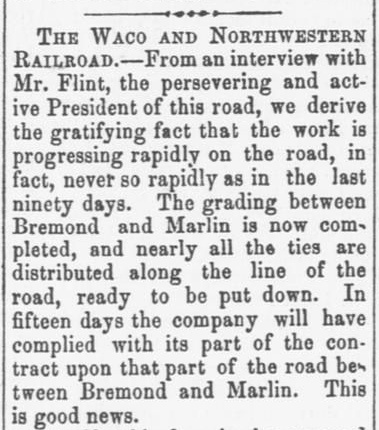 |
As
explained by Reed, H&TC's track-laying for the W&NW did not stop at Waco; it
continued to Ross in
late 1872, ten miles farther northwest. There was nothing special about the tiny
community of Ross; it was simply in the right direction as H&TC wanted to
demonstrate its commitment to building to the Panhandle. The timing coincided with H&TC
completing construction into
Denison where it connected to a new bridge over the
Red River built
by the Missouri, Kansas & Texas (MK&T) Railroad coming south across Oklahoma.
Reaching the Red River fulfilled H&TC's charter requirement, freeing it to
build its own branch lines. It also attracted the attention of Charles Morgan,
owner of a major steamship line operating in the Gulf of Mexico. Morgan had
recognized the need to acquire railroads to move goods in and out of the major
ports servicing his steamship line. To this end, he organized Morgan's Louisiana
and Texas Railroad and Steamship Company and then bought the H&TC in early 1877,
naming his son-in-law, Charles Whitney, as President.
With Morgan and his
family now in control, the H&TC and its investors refocused on the northwest
extension. To build it, they elected to use a separate railroad for which a
charter was granted on May 30, 1879. It was called the Texas Central (TC)
Railway and was backed by many of the H&TC's existing investors. Charles Morgan's death at age 73 on May 8, 1878 put Charles Whitney
firmly in charge of both the H&TC and the TC, which commenced construction out
of Ross c.1879. The 55 miles from Bremond through Marlin to Ross remained under W&NW ownership
controlled by the H&TC.
In 1883, SP acquired all of the Morgan interests,
but
the H&TC was allowed to operate under its own name as a wholly-owned
subsidiary. The
Depression of 1882-1885 had already begun, and it hit railroads particularly hard.
The H&TC entered receivership in February, 1885 and SP lost control of it. In April,
1890, a financial reorganization resulted in the chartering of a new Houston &
Texas Central "Railroad" (not "Railway", as originally named.)
The W&NW had
been separated from the H&TC by the Bankruptcy Court and remained in
receivership, to be sold at auction. The new H&TC proceeded to buy the
Houston - Denison main line from the bondholders, and then SP
reacquired the new H&TC shortly thereafter.
The auction for the W&NW was held
December 28, 1892 on the steps of the McLennan County Courthouse in Waco. SP
lost the auction to Hetty Green, a wealthy Wall Street investor
represented by her son, Col. E. H. R. Green, but a lawsuit
was filed over the terms
of the sale pertaining to first mortgage bonds. A court set aside the results of the
auction, and after a lengthy court battle, a second auction was
held on September 3, 1895. This time, the auction was won by Wilbur F. Boyle, an agent
secretly acting on behalf of SP.
Extensive litigation followed. In a nutshell...
although the "new" H&TC owned the main line and rolling stock, the
remaining assets and obligations of the "old" H&TC and other Morgan
interests were still being unraveled to decide what could be liquidated
and paid to the bondholders. The
"old" H&TC's ownership of the W&NW created legal obligations regarding
first mortgage bonds (hence it had been separated so that the H&TC
reorganization could proceed.) Though Boyle had won the auction, he could not
complete the sale because the W&NW was still held in receivership while
the lawsuit against the "old" H&TC was litigated. The W&NW was being
operated in the interim under court supervision and was continuing to
make a profit. Should the profits be held for Boyle to receive, if and
when the sale was finally completed? Should they be paid to the W&NW's
bondholders? How much profit was there? It was a jobs program for
lawyers... The Federal District Court in Galveston handled the case and
assigned a Special Master to sort out the details and
issue reports to the Court. Naturally, every report from the Special
Master resulted in motions to the judge by one side or the other
disputing various details. Finally, after appellate rulings from the
Fifth Circuit Court of Appeals in New Orleans, the case wound down.
Right: The
Galveston Tribune of July 7,
1898 reported the end of the W&NW receivership. Six days earlier, Boyle
had been able to convey the W&NW property title to SP's new H&TC
subsidiary. Although Alfred Abeel is noted in the article as the Special Master, he
was actually the court-appointed Receiver for the W&NW. The Special Master
was Col. William L. Prather, who resigned his position with the Court on
February 19, 1900 (the remainder of the lawsuit was still
going on!) as he became President of the University of Texas, an
institution he had served for many years on the Board of Regents. He is
the namesake of
Prather Hall on the Austin campus. |
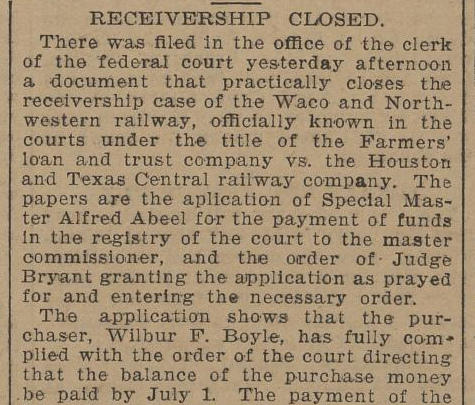 |
While Alfred Abeel had been running the W&NW as
the court-appointed Receiver, the railroad had performed well. Abeel had to get Court permission for capital expenditures, but since the
railroad was making a profit, such approval was typically forthcoming. By 1896,
Abeel knew he needed new depots in Waco and Marlin.
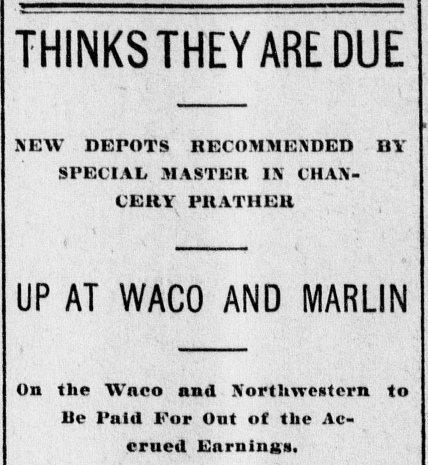 |
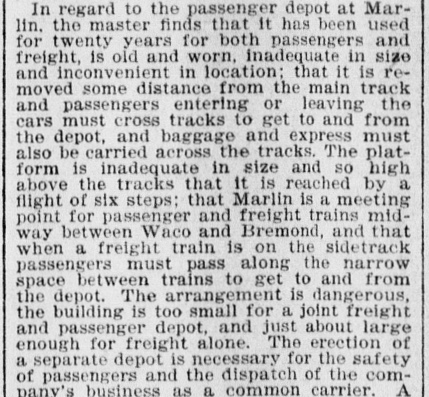
Left and Above:
Galveston Daily News, April 18,
1896 |
In 1892, the City of Marlin accidentally discovered hot mineral water
when it drilled an artesian well for municipal use. Soon, the "healing benefits" of
Marlin's mineral waters were being marketed to the general public, many of
whom arrived by train on the W&NW. The first bath house was completed in 1895
and the Arlington Hotel was built that same year as an elaborate facility for
visitors who came to enjoy spa treatments. Additional hotels were built,
and a substantial industry
developed in Marlin around bath houses and spa facilities catering to
travelers who came to "take
the waters." Four major league baseball teams held spring training in Marlin
in various years (c.1904-1918), always staying at the
Arlington Hotel. The spa industry continued through the 1930s and then
began to fade away.
Left:
It seems likely that the growing influx of spa visitors to Marlin
arriving on the W&NW motivated Abeel to request approval of a new passenger depot. The judge
assigned it to Special Master Prather who issued a favorable report on
the idea. Abeel's request also included building a new freight depot at
Waco. [Note that "UP" in the headline does not refer to Union Pacific!
It is simply that from the perspective of headline writers in the
Galveston press, almost everything happening in Texas was "up", as in
"up north".] |
Below: The mineral waters industry in
Marlin was no "mom and pop" operation. (University of North Texas collection,
Portal to Texas History)
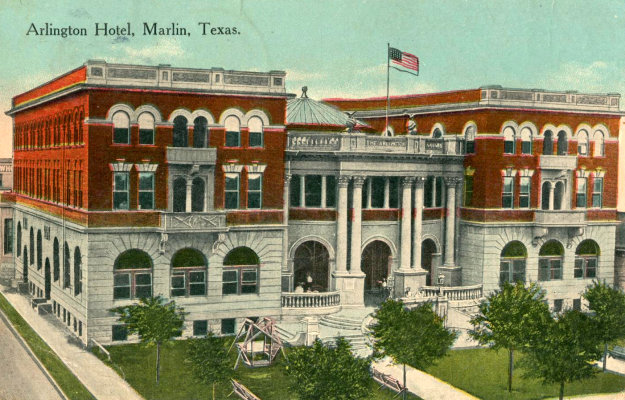

As the mineral waters fed Marlin's economic growth in the late 1890s,
the town
became targeted for additional rail service. The International & Great Northern
(I&GN) Railroad, one of the largest in Texas, had begun to contemplate a new
rail line to connect Fort Worth and Waco with
Houston and Galveston, with the
route passing through Marlin. The I&GN
was controlled by the family of rail baron Jay Gould who had died in December,
1892. His rail empire had passed to his sons George and Edwin. Edwin ran the St. Louis Southwestern ("Cotton Belt") while George ran the
I&GN and the Texas & Pacific, plus additional railroads outside of Texas
(notably, the Missouri Pacific, which had been evicted from Texas when its lease
of the MK&T was broken by the Texas Supreme Court in 1891.) Because
Fort Worth had become a major rail gateway to the north and west, the belief was
that a faster, more direct route from Fort Worth to Houston and the Port of
Galveston would pay dividends for the I&GN.
Like
many other rail executives, George Gould elected to charter a separate railroad, the
Calvert, Waco and Brazos Valley (CW&BV), to handle the construction of the
new line, ostensibly from
Valley Junction (near Hearne) to
Waco and Fort Worth.
At Fort Worth, the I&GN would connect with several railroads; it had no existing operations there,
but the Texas & Pacific led by Gould had a major presence. Although Valley
Junction was on the I&GN main line between Longview and Laredo, neither of those
endpoints was in the direction of Houston, hence there was no practical benefit
to Valley Junction being the southern terminus of the new line. The charter was
revised on May 6, 1900 to make Bryan the southern terminus, but there was no
I&GN connection there at all. From Bryan, a trackage rights agreement with the
H&TC would be needed to reach Houston, and there was no assurance that a deal
could be made (no doubt H&TC was very
unhappy with I&GN's plan to serve many of the same towns along the Brazos.) The charter was revised again in December,
1900 to move the south endpoint to Spring, just north of Houston on
another I&GN main line that ran to Palestine. It was feasible to build
to Spring, and the line from Spring into Houston connected with the Galveston,
Houston & Henderson (GH&H) of which I&GN was half-owner. I&GN
possessed an independent and unlimited right to use the GH&H tracks to reach Galveston.
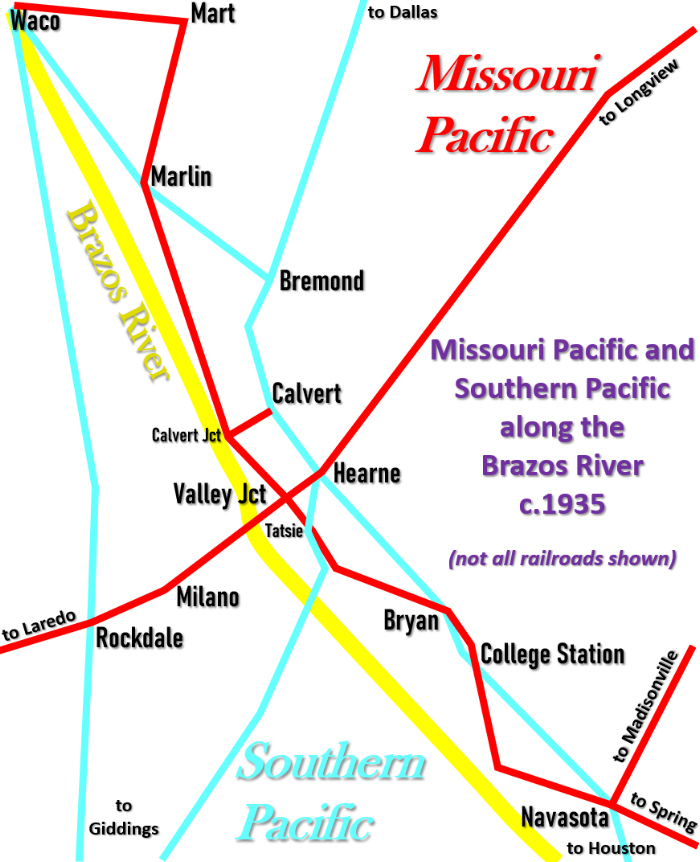 |
Left:
area map showing SP and MP rail lines along the Brazos River between Waco and
Navasota -- other railroads not shown
From Waco, the new
I&GN tracks would parallel the Brazos River much of the way south,
passing through Marlin, Valley Junction, Bryan, College Station and
Navasota. Except for Valley Junction, all of these towns were already
served by the H&TC, and Valley Junction was only four miles from the
major H&TC yard at Hearne. (Note that SP's line from Giddings through
Tatsie to Hearne shown on the map was built later, c.1914.) The two railroads' proximity created serious conflict
between them, and there was litigation associated with
crossings and rights-of-way.
The entire line between Spring and Fort
Worth was built in disjointed pieces by multiple I&GN crews. New
construction reported annually to the Railroad Commission of Texas (RCT)
reflects the nature of the effort.
1900: Calvert to Valley Junction, 14.3 miles
(CW&BV)
1901: Valley Junction to Bryan, 22.75 miles (CW&BV)
1901: Calvert Junction to Marlin, 28.65 miles
(CW&BV)
1902: Bryan to Spring, 78.22 miles (I&GN)
1902: Marlin to Waco, 41 miles
(I&GN)
1903: Waco to Fort Worth, 94.55 miles (I&GN)
In February,
1901, an act of the Texas Legislature allowed the I&GN to acquire and
merge the CW&BV, hence all post-1901 mileage is attributed to the I&GN.
In addition to Tower 191 at Marlin, the locations on this map that
were interlocked are Waco (Towers 59, 21,
8 and
144), Valley Junction
(Tower 194), Hearne (Tower 15), Tatsie (Tower 140), Bryan (Tower 36),
College Station (Tower 7), Navasota (Towers
9 and 41), Milano (Tower 23)
and Rockdale (Tower 54).
The overall
design of the I&GN line between Spring and Fort Worth sacrificed grade
quality for construction speed, and opted for circuitous routes in
places to mitigate direct competition with the H&TC. This did not bode
well for the long term since
the I&GN's objective was a faster
route to Houston. Its Fort Worth Division became notorious for wrecks,
derailments and slow orders due to bad roadbed, poor signaling and
numerous curves. The Brazos River and its
tributary creeks flooded periodically creating more problems.

Above:
Railway Journal, April, 1901 |
Wayne Cline described the I&GN construction in his book
The
Texas Railroad ((c) Wayne Cline, 2015)...
...the Fort Worth Division was built
with "rapid-fire" techniques, which were not noted for producing safe and
durable results. By 1902 short trains were rocking slowly along the wavy tracks
of the new Fort Worth Division, and the following year found them creeping over
a new 45-mile branch between Navasota and Madisonville."
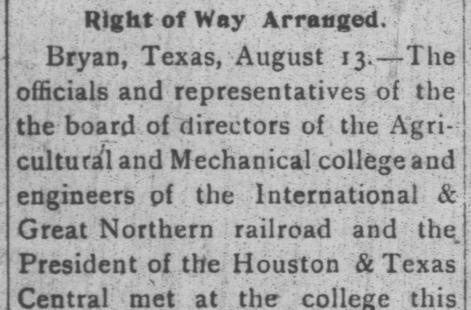
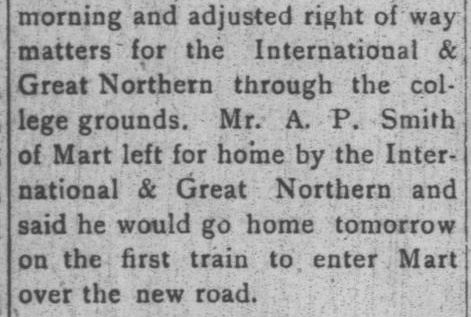
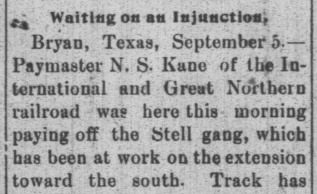
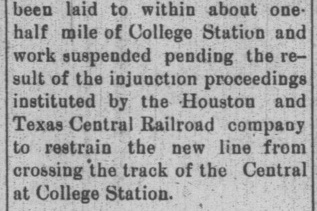
Above Left: The
Navasota
Daily Examiner
of August 14, 1901 reported on a meeting between the two
railroads at College Station regarding the I&GN's "right of way ... through the
college grounds." Above Right:
Three weeks later, the September 6 issue of the newspaper reported that track work had been suspended
within a half-mile of College Station due to an injunction obtained by the H&TC
to temporarily prevent the I&GN from crossing the H&TC's tracks. The I&GN eventually won the case and was allowed to
proceed across the H&TC at College Station. This became one of the earliest
crossings to be interlocked, commissioned by RCT on February 21, 1903 as
Tower 7.
H&TC instituted a couple of legal roadblocks to try to
deter the I&GN's construction, or at least steer it away from putting its grade
directly beside the H&TC tracks. They lost in court, but they may ultimately
have influenced I&GN's route. Despite grade crossings of the two railroads at
Navasota, College Station, Bryan and Marlin, the tracks never ran side-by-side
for any significant length until the crossing at Tatsie was built by SP in 1914
as part of the "Dalsa Cutoff" between Giddings and Hearne.
That
the Fort Worth Division's construction had begun at Calvert (a town on the H&TC
between Bremond and Hearne) is perhaps indicative of the chaotic nature of I&GN's planning. S.
G. Reed wrote that the original concept was to build from
"...Valley Junction on the Longview-San Antonio Line through Calvert to Fort
Worth...", but despite Calvert being prominent in the CW&BV
name, it wasn't even on the main line when the project was
finished. The initial construction by the CW&BV began at Calvert and went west far enough (five miles) to cross the Little
Brazos River. Safely ensconced a quarter mile west of the Little Brazos and a
mile east of the "big" Brazos, the tracks made a 90-degree turn to the
south to reach Valley Junction. The turn became known as Calvert Junction when
it was subsequently used as the starting point from which to build north to
Marlin. Thus, the actual main line ran between Valley Junction and Marlin, with
Calvert merely the endpoint of a five-mile spur.
Sanborn Fire Insurance maps of Calvert show that the I&GN and H&TC served the
same cotton processing facility but otherwise did not connect at Calvert.
Because of population growth
in Marlin, the I&GN had difficulty obtaining a right-of-way through town,
and ultimately, the only choice was to run its tracks through the heart
of Marlin on Falls St. and Ward St. This made operations in town very slow and
somewhat dangerous due to wagon and pedestrian traffic. The
Jefferson Jimplecute of February 2,
1907 (in what can only be characterized as random filler from
a town 180 miles away) reported that while "improving its track",
the I&GN "...is making needed improvements to portions of Ward and
Falls streets." Perhaps Jefferson residents liked to go to Marlin
to take the waters?
Right:
This snippet from the 1903 Sanborn Fire Insurance Co. map of Marlin
highlights the I&GN track running through Marlin's Public Square, where
Falls St. becomes Ward St. along the east side of the Falls County
Courthouse. A county courthouse located this close to a railroad main
line must have been rare in Texas, even in 1901. It was obviously a busy
area filled with people and commerce. Delays were mitigated somewhat by
the I&GN passenger depot being located one block south of the square; trains would have been moving slowly
anyway arriving or departing the depot.
To the north, the H&TC
(W&NW) already occupied the optimum route between Marlin and Waco, so the I&GN chose to take a circuitous path from Marlin north to
the community of Mart and then west to Waco. While this was an economic boon for
Mart -- its population grew from 300 to 3,000 over the next decade -- it made the I&GN's route slower and more expensive to operate.
Eventually, Mart became the I&GN division point and a yard was built
there. Operations to the south were in the Mart District and operations
to the north were in the Fort Worth District. |
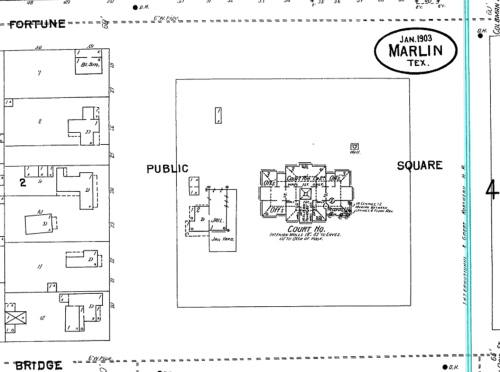 |
The I&GN went into receivership in 1908. This was
partly from economic conditions and partly from financial miscalculations by George Gould
pertaining to railroad investments elsewhere in the U.S. Gould issued a
statement blaming it on orders issued by RCT that would require large expenditures to improve the I&GN's infrastructure.
RCT stuck to its order, though it was roundly criticized throughout the railroad
industry. While other railroads were ordered to make similar improvements, RCT
rightfully had very serious concerns about the I&GN. The new Fort Worth Division
was the culprit, though it comprised just 25% of the I&GN's track
mileage. Wayne Cline explains that after Gould had taken control in the wake of
his father's death in late 1892...
"...the International and Great
Northern had compiled a reasonably acceptable safety record, but it went rapidly
downhill shortly after the Fort Worth Division was constructed. In 1904,
casualties suddenly soared when 139 workers and passengers were injured --
almost twice the average for the previous ten years. ...[in 1908] Commission records
showed that 99 wrecks had occurred on the I&GN since the summer of 1907, and 41
of them occurred on the newly laid track of the Fort Worth Division."
In 1911, a new I&GN company was organized to take over the assets and operations of the old
company, with the Gould family still in charge. In early 1914, the I&GN again
returned to receivership, this time for several years which included the period under the U. S.
Railroad Administration during the World War. Another new company, the International -
Great Northern (I-GN) was formed in 1922 to acquire the I&GN out of
foreclosure, at which point the Gould family was no longer involved.
The I-GN's financial
reorganization coupled with its service to many of the major cities in Texas and
its thousand miles of track made it an attractive
target for acquisition. MP had gained independence from the Gould family in 1917
and wanted to buy the I-GN to reenter the Texas market, but the sale was nixed by the Interstate
Commerce Commission (ICC). Going to Plan B, MP
helped the New Orleans, Texas & Mexico (NOT&M) Railway buy the I-GN.
The NOT&M had become the corporate entity for a collection of railroads that
operated between New Orleans and Brownsville using the moniker Gulf Coast
Lines (GCL) under executive control of the St. Louis - San Francisco
("Frisco") Railway. The GCL had gained independence during the Frisco's
receivership in 1914 and it was also a candidate to be acquired by a larger
railroad. The
ICC approved NOT&M's purchase of the I-GN in 1924, and then allowed MP to buy the NOT&M on
January 1, 1925. This gave MP the I-GN plus all of the NOT&M railroads -- a
sudden and massive presence for MP in Texas. In 1933, MP went into a lengthy
receivership which likewise compelled a receivership for the I-GN.
Operating for more than two decades under court supervision, MP finally emerged from bankruptcy in 1956. MP dissolved the I-GN
at that time and integrated
its operations under the MP name.
In 1927, SP chose one of its Texas
subsidiaries, the Texas & New Orleans (T&NO) Railroad, to become its primary
operating entity for Texas and Louisiana. SP began leasing its various Texas and
Louisiana properties to the T&NO and in 1934, merged them into the T&NO
corporation. Although this did not include the Cotton Belt, of which SP had
gained control in 1933, it did include the
H&TC and W&NW. All subsequent SP operations through Marlin were under the T&NO name.
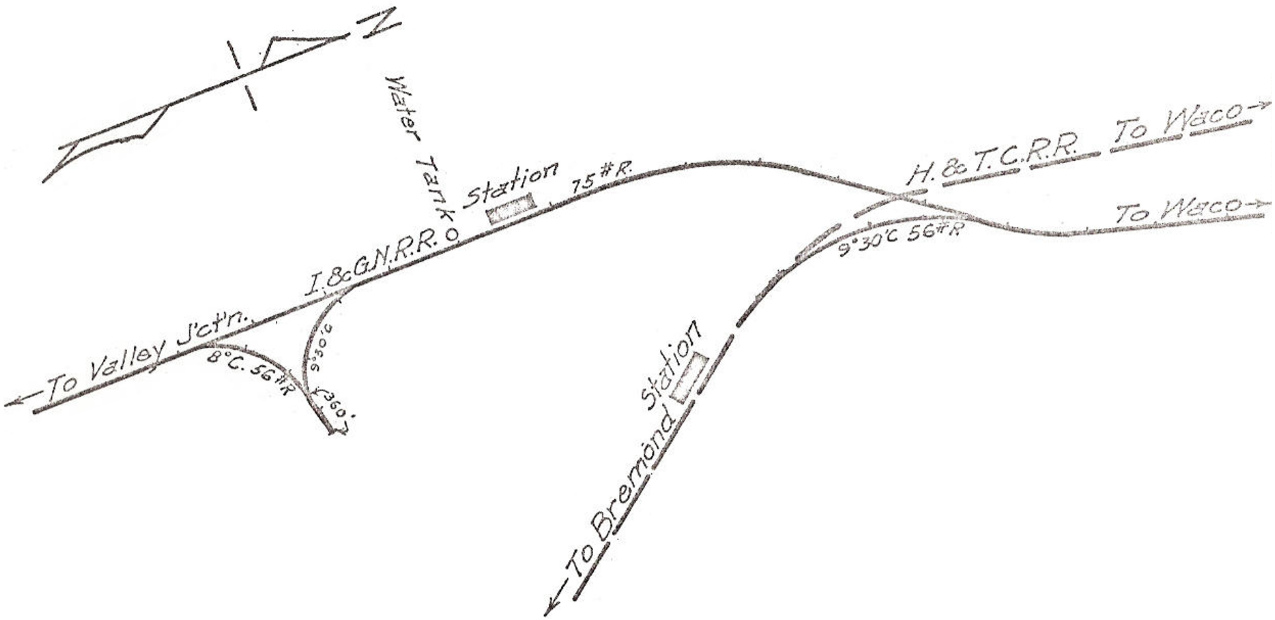 |
Left:
1915 track chart of Marlin from the MK&T railroad's Office of the Chief Engineer
(courtesy Ed Chambers) Below:
An automatic interlocker for Marlin was ordered in 1945 by the I-GN. It was
commissioned as Tower 191 by RCT on January 18, 1946.
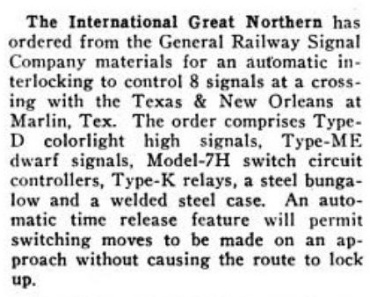
Above:
Railway Signaling, June, 1945 |
Right:
SP used an internal drawing known as a D-205 to provide summary
documentation for the interlockers in which it had a financial interest.
The upper portion of the original D-205 for Tower 191 shows that the
contract between the two railroads dated to the last day of 1944. Just
over a year later, the interlocker was commissioned for operation. Since
the T&NO was the "Senior Company", the I-GN had responsibility for the
capital expense for the interlocking plant and associated signals. The
bottom of the document (not shown) indicates that the recurring expenses
were shared in the ratio of 41.18% for the T&NO and 58.82% for the I-GN.
(Carl Codney collection)
The specific impetus to interlock the Marlin crossing in 1945 rather than years earlier is
undetermined. Presumably the crossing was gated, most likely against the T&NO.
The Waco branch had never been a main line for SP, and a 1941 T&NO timetable
shows only one mixed train daily each way through Marlin. Despite all of the
infrastructure problems during the Gould era, MP made substantially greater use
of its Fort Worth Division. Assuming the crossing was gated against the T&NO and
that MP trains were operating at restricted speed near the depot anyway, MP might
have had little incentive to pay the capital expense for an automatic interlocker.
Thus, the decision to interlock the Marlin crossing might have resulted
from an order by RCT. In October, 1959, the D-205 was revised because a T&NO
siding or spur track was removed. This reduced T&NO's recurring expense
share to 36.51%. |
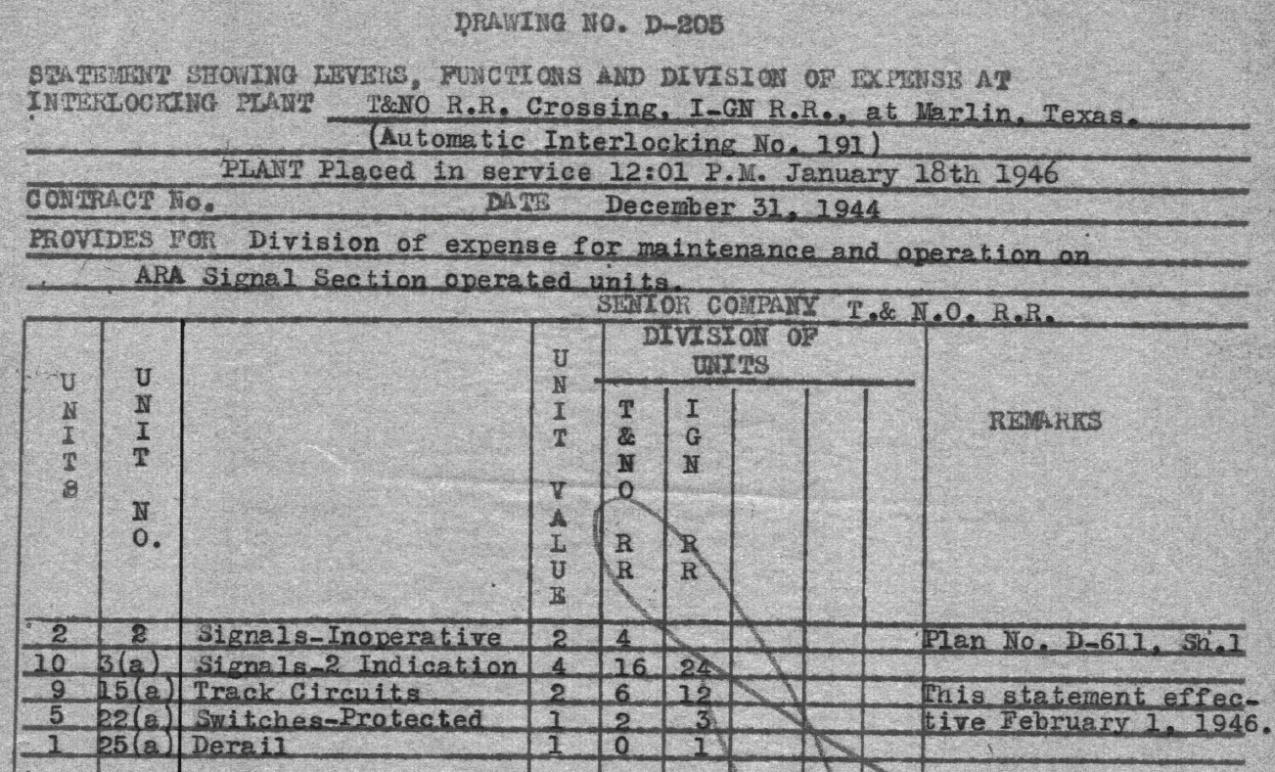 |
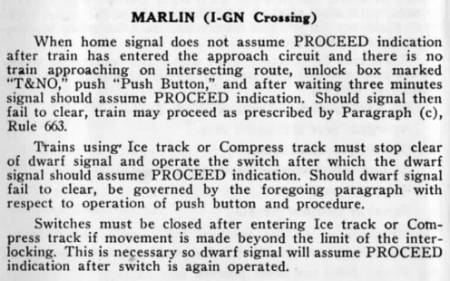 |
The precise date the Marlin interlocker was commissioned
for operation is undetermined, but it is listed as an automatic interlocker in a
T&NO Employee Timetable (ETT) dated May 19, 1946. With a June, 1945
ordering date, it was probably installed in early 1946.
For
whatever period of time the I&GN tracks from Valley Junction ended at
Marlin in 1901, there would have been no reason to extend them past the
depot to the point where they crossed the H&TC farther north. Thus,
installation of the crossing diamond most likely occurred when the I&GN
proceeded with construction from Marlin to Waco in 1902. On that basis,
I-GN would have taken the lead in ordering the interlocker because it
would have been paying all of the capital expenses. For crossings that existed as of 1901, RCT required
the railroads to share interlocker capital expenses equally, but the
Marlin crossing most likely dated from 1902.
Left: These special instructions from the 1946
ETT indicate that there was a control box mounted at the crossing to be
used for overriding the signals when necessary. This is common for
automatic interlockers, e.g. Tower 70, Tower 103,
Tower 127. The "Compress track" refers to a
cotton processing facility identified on Sanborn Fire Insurance maps as "Exporters and Traders Compress and Ware
Ho." southwest of the diamond. It was served by both railroads. |
Over many years, SP's track and infrastructure
development in Texas had rendered the route through Marlin unnecessary. The mixed train
daily on T&NO's schedule in 1941 remained the only regular operations on the
line. A 1962 timetable lists only a single daily freight in each direction;
passenger service had apparently been dropped. With little commerce on the line,
the T&NO
proceeded to abandon its Waco Branch through Marlin in 1965. MP took this opportunity to eliminate the lengthy segment from Marlin to Waco
via Mart by purchasing T&NO's more direct route.
Rather than connecting to the T&NO tracks at the Tower 191 crossing, MP chose to eliminate
the tracks on Ward St. and Falls St. by using T&NO's entire route
through town. Tower 191 no longer served a crossing so it was decommissioned, but
the plan necessitated construction of a short connecting track in south
Marlin. Today, this route remains a UP main line.
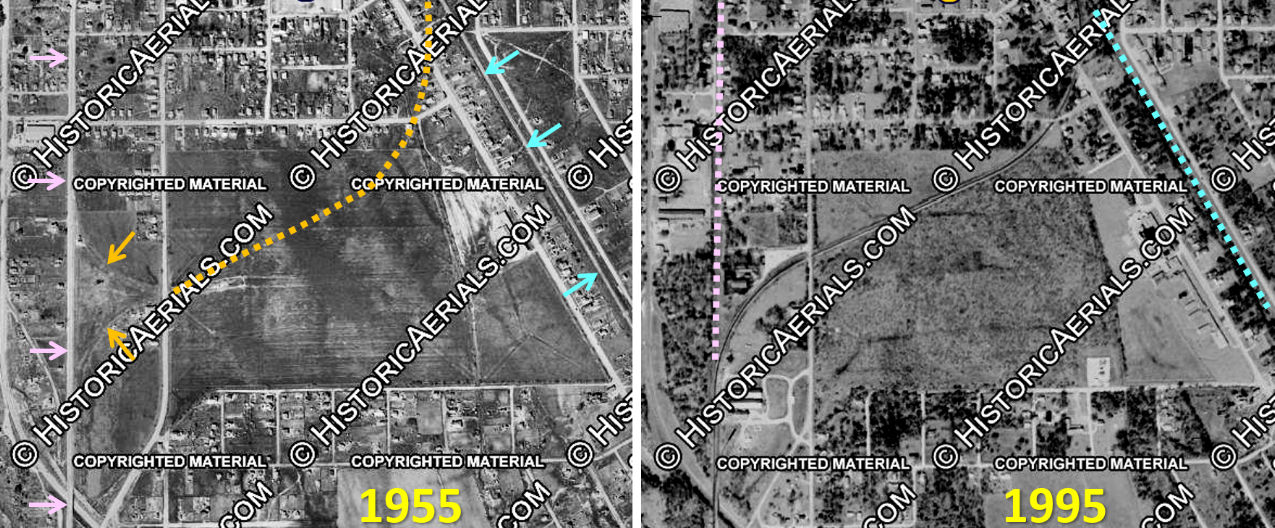
Above: These two aerial images ((c)historicaerials.com)
captured forty years apart show the revisions to the tracks on the south side of
Marlin that resulted from MP buying SP's route to Waco in 1965. Prior to the sale, the
MP tracks (pink arrows) ran north/south along the west side of Marlin while the
SP tracks (blue arrows) ran northwest/southeast on the east side of Marlin. The 1955
imagery shows that MP had a wye (orange arrows) going east off the main line;
the wye also appears on the 1915 track chart. MP used the south leg of the wye as the starting point for the new connector
(orange dashes) that ran northeast and curved onto SP's tracks. The connector is visible in the
1995 image. The end result was that the MP tracks north of the connector (pink
dashes) and the SP tracks south of the connector (blue dashes) were abandoned.
Below Left:
Looking west, the north and south legs of MP's wye merged at the Bennett St.
grade crossing. The south leg was used as the lead for the connecting track to
carry MP trains to SP's tracks and is now part of UP's main line. The north leg
was abandoned, but its path ran northwest past the utility pole at right of
center where a vague right-of-way is visible extending into the distance.
Below Right: Looking north-northwest from
the former Tiller St. grade crossing, SP's right-of-way from Bremond shows a slightly
elevated grade paralleling Kennedy St.
About 0.6 miles distant, the grade becomes occupied by UP's tracks where MP's
connecting track merged into SP's line to Waco. The connecting point was
formerly the Conoly St. grade crossing, but barriers were erected to block the crossing and little remains of Conoly St. today.
(Google Street View images)

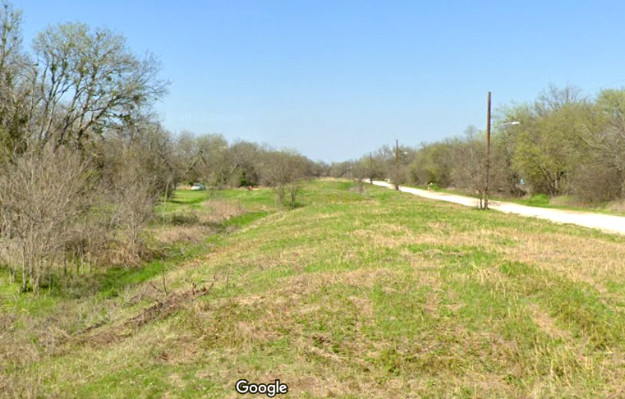
In 1982, UP acquired MP but continued to operate it as
a wholly-owned subsidiary. In 1996, UP acquired SP and shortly thereafter, SP
and MP were integrated into UP's operations and they ceased to exist as separate
railroads.

Last Revised: 9/13/2024 JGK - Contact the
Texas
Interlocking Towers Website.























